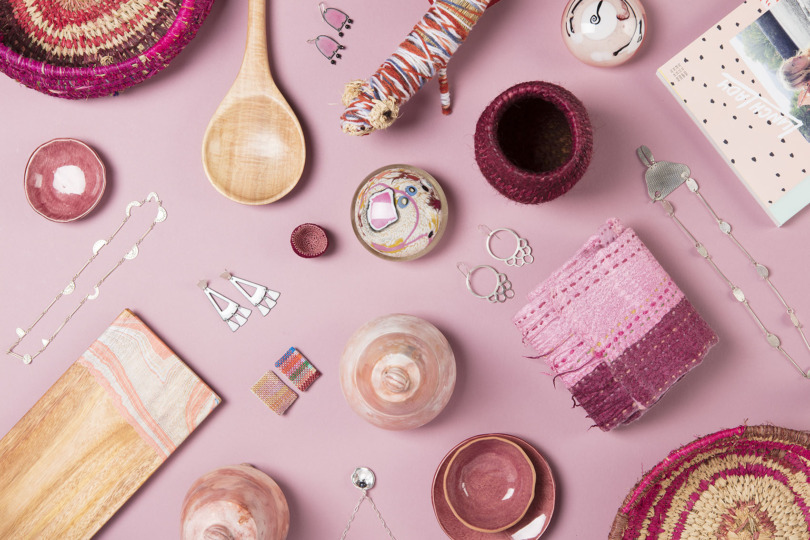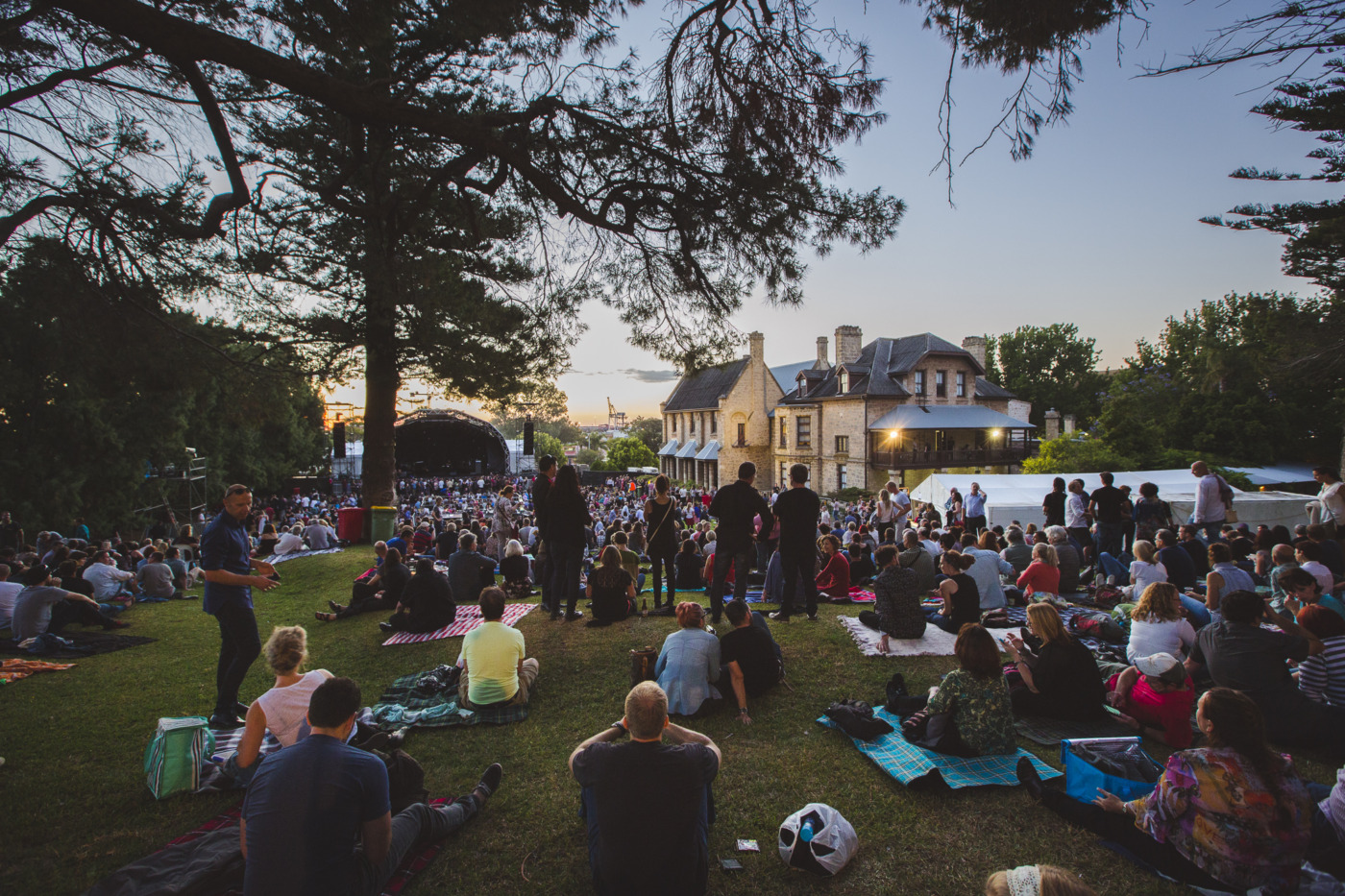Treat mum this Mother’s Day with a unique gift from our shop FOUND at Fremantle Arts Centre. We stock the largest range of locally made and designed products in WA with work by Perth artists, regional makers and artists living in some of the most remote locations in the state. Find remarkable ceramics, jewellery, textiles, fashion, woodwork, books, toys and more. FOUND is open 9am–5pm, daily.

Spoons and knives by Tony Docherty, woven vessels by Sian Boucherd, ceramics by Stephanie Hammill, terracotta series by Anthea Carboni and woodfired range by Stewart Scambler
At FOUND you can peruse our vast range of wares and learn the stories behind each piece. Our shop staff are artists, makers and designers with a great depth of knowledge about how each work is made. Many artists stocked in our shop also teach in our extensive learning program. Why not find a special, handmade piece for mum and pair it with a complementary course?
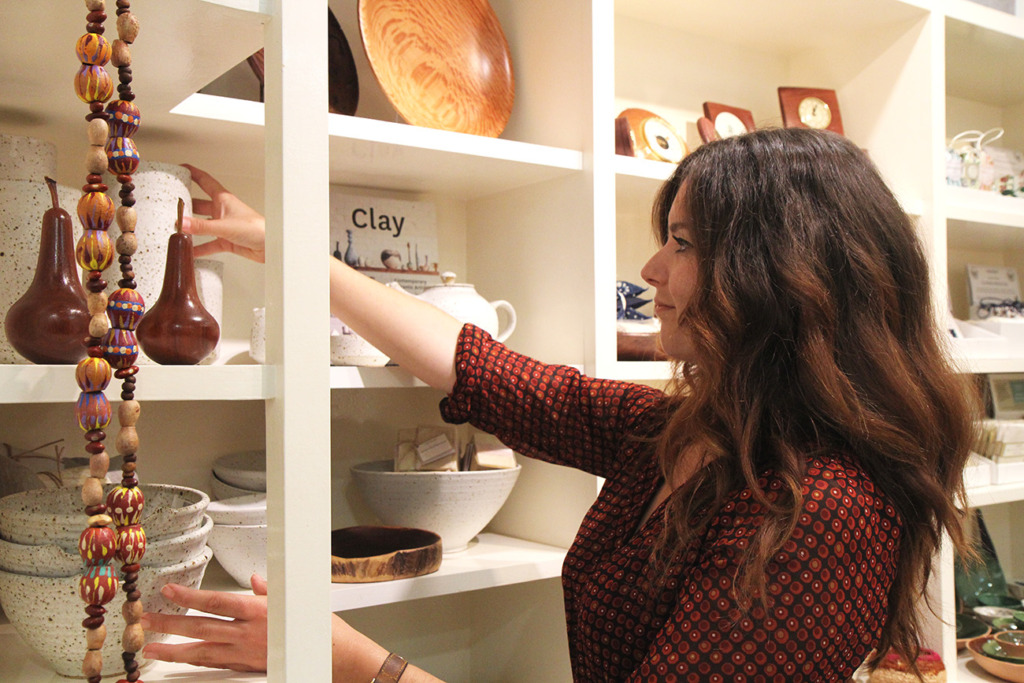
Wooden pears by Roger Pike, speckle range by Stewart Scambler, wooden bowl by Roger Symons, soaps by Thurlby Herb Farm, wooden dishes by Tony Docherty and gumnut strings by Papulankutja Artists
Taiwanese artist Alice Lin has always had a fascination with native flora and fauna. She’s currently our Asialink Artist in Residence and has been creating whimsical sculptures based on well-known Australian animals. Her playful ceramics re-imagine real-life animals, adding new features to create strange and beautiful hybrids. We chatted to Alice ahead of her exhibition Muah! opening on Sunday 7 May.
Tell us about your art practice and how you first discovered ceramics.
I studied art at Tainan National University of the Arts from when I was 18, then I did my Masters of Fine Arts and finished that last year. In my BA we learnt everything, not only ceramics but all art forms. Then in third year we got to choose the material we wanted so I chose ceramics. It’s so flexible! You can make something out of anything, like wood and metal.
Your work is playfully surreal, filled with absurd, fantastical creatures. How do you come up with your unique ceramic animals?
I love animals and plants. The first time I came to Australia was three years ago and I saw many different creatures. It made me think more about myself and the way we all interact with the world. I saw koalas, kangaroos, many birds and lots of parrots. I have a parrot at home called Golden Flower. When I see an animal like a bird or a seagull, I think about the kind of personality they have and match those parts of my personality and try to think of a story about it to transform it into something else.
One of the reasons you wanted to come to Australia was to meet our marsupials after first seeing them on the Discovery Channel. What was it about them that inspired your visit? Have you managed to see any since you arrived?
I saw kangaroos on the television and I felt they were so interesting. The mum and the baby stay in the same body, they are like one but they are two. I’d not seen animals like that before. Sometimes I imagine animals that might exist but we don’t know them or can’t find them. I feel like that about kangaroos, that they’ve been imagined.

Alice Lin, At First Sight, 2017, glazed stoneware, 15 x 40cm
You’ve been in residence at Fremantle Arts Centre since February, working on your upcoming exhibition Muah! What’s the experience been like?
It’s really fun. When I got here and I saw the environment and also Fremantle city, I thought it’s so beautiful. I feel so lucky. People have been very friendly and very kind. I’ve gone down to Margaret River, Penguin Island and Rottnest Island. The first time I saw the quokkas I just wanted to touch them! But for people there they feel so normal, they’re like a dog or pet to them. They always smile. They call them the happiest animal in the world because when you take a photo their face is always smiling. I saw them on the internet before I came. So cute!
In Margaret River I saw a stingray just near the coast. They’re so big! I saw many dolphins too, even just near the harbour. In Taiwan we have mostly birds and deer. On Orchid Island we have goats, more goats than people. I like that in Australia humans respect animals very much. It’s not like this in Taiwan, but we are working on it.
For Muah! you’ve drawn from our local flora and fauna to create imaginative hybrids of some of Australia’s most well-known animals. Tell us about these new creatures that you’ve made and the animals that inspired them.
I made my deer with two heads because I always worry about being careful and watching out for things around me. In our culture if you see an animal with two heads it’s unlucky, like the snake with two heads, but for my deer I feel that he is pure and worries a lot. I don’t want people to know what kind of animal my sculptures are straight away, I want them to imagine. So I try to make something always slightly different. My deer has a really fat tail so people might think it’s like a deer or maybe more like a dog.
I saw an echidna and it made me think of myself also. Sometimes I want to get close to people but I worry, and am too self-protective. When I came here I felt too happy so I made an echidna with a smiling face. It’s like my pet. My creatures make me really happy, that’s why I called my exhibition Muah! like a kiss. I can’t stay in Australia forever but my creatures can. That’s another reason why I don’t want to take them back to Taiwan, because they are born here.
What’s up next for you?
I will be looking for another residency program in Australia or New Zealand to see more wildlife and to turn them into my artwork. I’ve always wanted to go to New Zealand!
Muah! runs from Sunday 7 – Sunday 21 May
Elizabeth Bills is one of FAC’s many artists in residence, busily working away in studios hidden throughout our building. With a background in anthropology, Liz draws from everyday life to create her clever, evocative installations that offer emotive and often darkly comedic insights into her world. For her latest exhibition For The Lonely, she’s tackled feelings of loneliness to create an unusually accessible show that’s designed for audiences to touch.
Your artwork often seems to act as a way of exploring your own experiences, from work life to childhood and now feelings of isolation. Tell us about your practice and how it’s developed.
I have a contemplative approach to life and I often wonder why we as humans act the way we do. Having an art practice is how I process my own experiences; it’s where I give myself time and space to reflect. My previous exhibition Snakes and Ladders: a catalog by a receptionist, was an attempt to reflect on my time working as a receptionist. For The Lonely is an introspective look into my life a few years ago when I felt deeply lonely. Though those feelings have now lessened, I find it incredibly comforting to create work on that period of my life and feel less isolated as a result.
You’ve been preparing for your upcoming group exhibition For The Lonely while in residence. What have you been creating?
I’ve been using the space to collaborate with the other artists I’m working with for the show. We’ve been creating a variety of works with diverse mediums, including felting into fabric, creating clay sculptures, designing a 3D printed sculpture, exploring the properties of faux fur and embroidery. I’ve also been able to collaborate with other local artists while in residence, and to use the space for group workshops focusing on the finer details of performance art.
You’ve worked with seven other artists for this project. Why did you decide to work with others on an exhibition about loneliness? Are these various experiences of isolation an important part of the concept?
Loneliness is a subject that’s rarely voiced, and often just whispered about. In order to process my own experience of loneliness, I mapped out an exhibition during a train ride I took in 2014. Two years later I asked seven local artists if they would like to collaborate on an artwork reflecting our personal experiences of loneliness. I decided to involve others because it became clear to me that loneliness is universal, and while people may not express their feelings openly, I believe everyone experiences this at one time or another throughout their life.

Lexalot Randolph & Elizabeth Bills. Photograph by Neil Francis
For The Lonely will feature a series of tactile, immersive installations. We’re so used to experiencing art in a purely visual way and to typically not being allowed to touch artworks in a gallery setting. What made you decide to flip this? How do you think this changes our experience of art?
Before this project began, the way I saw my audience was really as an extension of myself – people of the same age with the same life experiences. It was a subconscious assumption I had until I was really challenged to broaden that view by partnering with incredible organisations like DADAA Ltd and VisAbility. I realised there was a large, art-loving community out there who, due to a variety of barriers, were unable to fully engage with the work. Art galleries are often not accessible, be it via entry to the gallery, the nature of the artwork (predominately visual engagement) or the lack of knowledge from staff around providing sensory experiences. Working on this exhibition under their mentorship has been an incredible learning opportunity and I now wholeheartedly believe accessibility needs to be considered in all exhibitions and is something to consider from the inception of the work.

Photograph by Neil Francis
What’s up next for you?
A break! I want to take some time to do things other than work on exhibitions, but I know that will only last so long. I already have a plan for another body of work, I want to revisit my gap year experiences in Tanzania. I also want to keep learning! Over the past year I’ve met incredible artists working in this field and I hope I can collaborate with them in the future.
For The Lonely opens Sunday 7 May at PS Art Space Fremantle and features Mark Wahlsten, Toni Lynn Avis, Erica Clarke, Lexalot Randolph, Jenna Le May-O’Connor, Carly Lynch and Jessica Harlond-Kenny.
Audio-Described & Tactile Tour | Sat 6 May | 2:30–3:30pm | Free | RSVP Essential
Preview Performance | Sat 6 May | 4:30–9:30pm | 30min Sessions | Tickets $23–31
Soft Opening | Sun 7 May | 10am–2pm | Free | RSVP
Exhibition Runs | 6 May – 19 May | Every Tues – Fri | 10am–4pm | Sat – Sun | 10am–2pm
We’re excited to announce WA artist Holly O’Meehan as our inaugural Art Ichol exchange artist. Holly will be travelling to Art Ichol, located in the rural city of Maihar in Madhya Pradesh, India, to undertake a month-long residency this September. We caught up with Holly ahead of the trip and asked her about her plans for the exchange.
You’re a visual artist and also run your own small crochet wares business under the moniker Hook Paper Scissors. Tell us a bit more about your artistic practice and how you first got into crochet.
I graduated from Curtin University with a BA in Fine Arts and Art & Design in 2013. At that point my art practice focused on repetitive and organised process-based works, ranging from print to sculptural and performative. I developed my art practice in this direction until about three years ago when my Mum finally got me to join her in a small crochet class and I’ve been hooked ever since (pardon the pun). My practice has since taken a turn towards the handmade. I love the physicality of creating with your hands using ancient craft techniques. My current works attempt to honour these ways of old in a society dense with modern technologies.
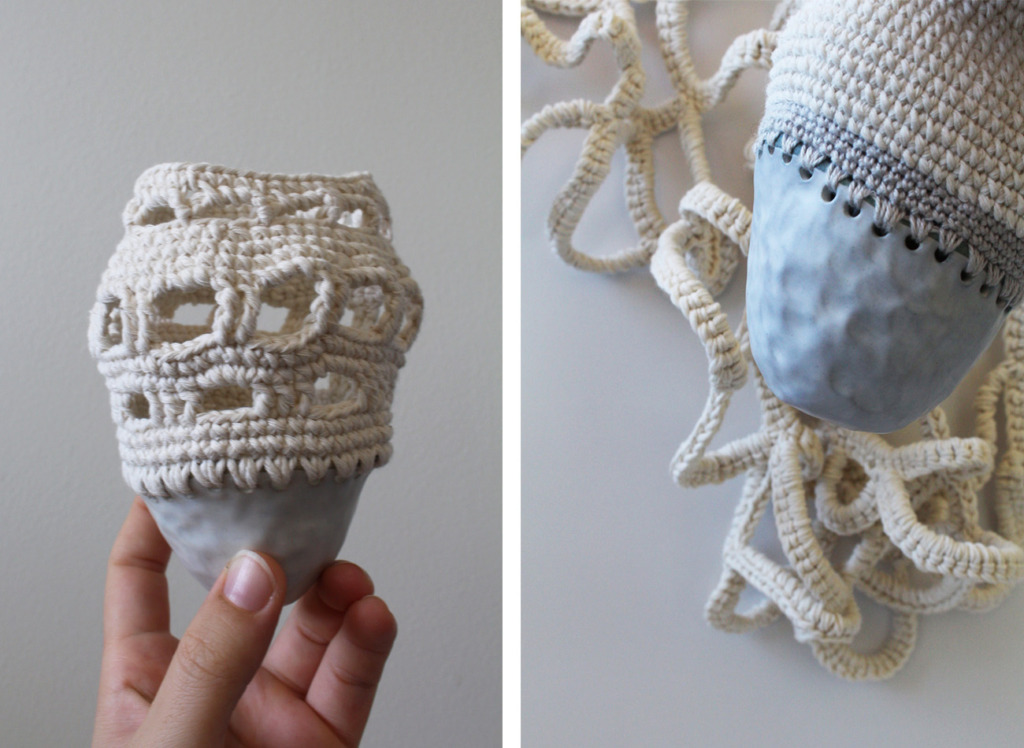
Holly O’Meehan, Functionless Vessel series, 2017, stoneware ceramic, glaze, cotton yarn, jute twine, embroidery thread, cotton rope, dimensions variable
Art Ichol has an incredible array of art facilities from a gallery, bronze casting foundry, stone and wood carving workshop, ceramic and pottery centre and painter’s studio. How does it feel to be the inaugural artist in residence for the FAC & Art Ichol Exchange Program?
I was in disbelief when I was first told, but now that it’s sunk in I couldn’t be more excited! Art Ichol has an amazing reputation and I can’t wait to learn and experiment with some new hand crafting techniques at these facilities.
What are your plans for your residency? Do you have any particular projects you’ll be working on or parts of your practice you want to develop?
I’m really interested in learning a range of traditional craft techniques from the Madhya Pradesh state including their carving techniques, wood block printing, gold embroidery, pottery, casting and various styles of weaving and jute crafts. Along with learning these craft techniques, I’m hoping to develop and explore the techniques that I already use through interacting at Art Ichol. I’d really like to develop my art practice by creating and experimenting in response to the space, people and culture.
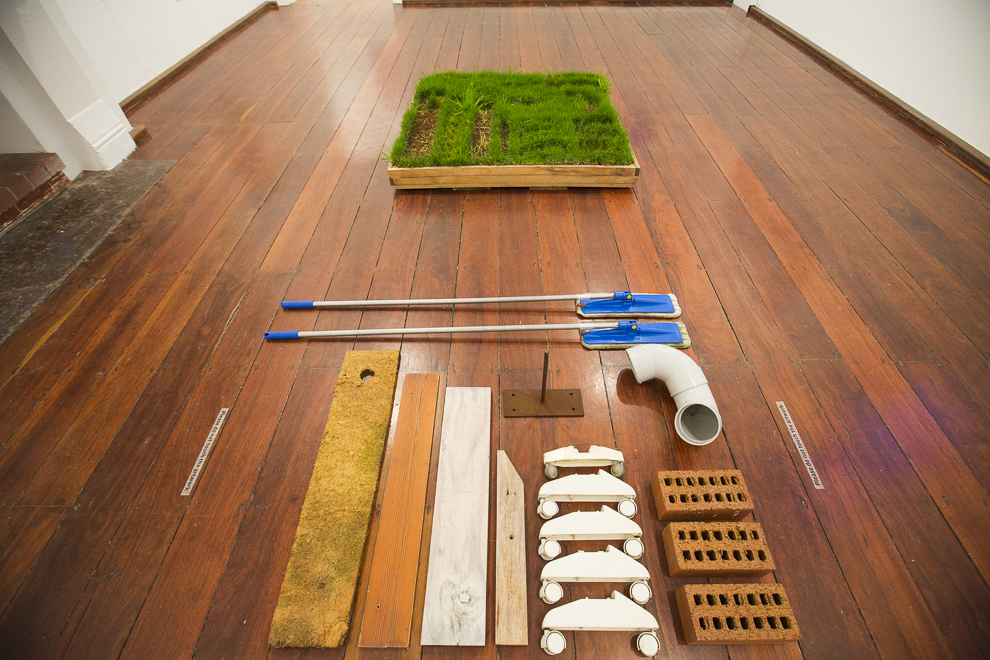
Holly O’Meehan, Arrangements of a Verge Collection, 2014, roll out turf, treated pine planter box and found objects, 120 x 290 x 15cm, 1/1
What other galleries and places will you be looking to visit while you’re in India?
The old city of Maihar where Art Ichol is situated has a selection of ancient temples that I’m really looking forward to exploring. I also hope to see where some of these traditional craft techniques were originally developed, amongst the people and their homes.
Are there any Indian artists you particularly admire?
Art Ichol always has a range of local and international Artists in Residence at the centre so it’ll be great to meet all of the other artists while I’m there. There are a few contemporary Indian artists whose sculptural works and art practices I admire. There’s Rina Banerjee, a female multi-disciplined sculpture artist whose intricate creations play between delicate handmade elements and mass-produced found objects. I also really enjoy the work by collaborative duo Thukral and Tagra (Jiten Thukral and Sumir Tagra). I’m attracted to their style of brightly coloured yet crisp finish to immersive and sometimes interactive installations.
You’re off to Art Ichol in September. Where can we find you in the meantime?
I’m currently working on a collaborative installation as part of The Golden Wattle Hookers, a crochet duo between myself and Jill O’Meehan (my Mum). Our encapsulating crocheted creations will be part of Vancouver Art Centre’s upcoming exhibition The Wool Story in Albany. For the rest of the time I’ll be in my studio in Fremantle, creating and preparing for the exchange.
Learn more about the Fremantle Art Centre & Art Ichol Artist in Residence Exchange Program.
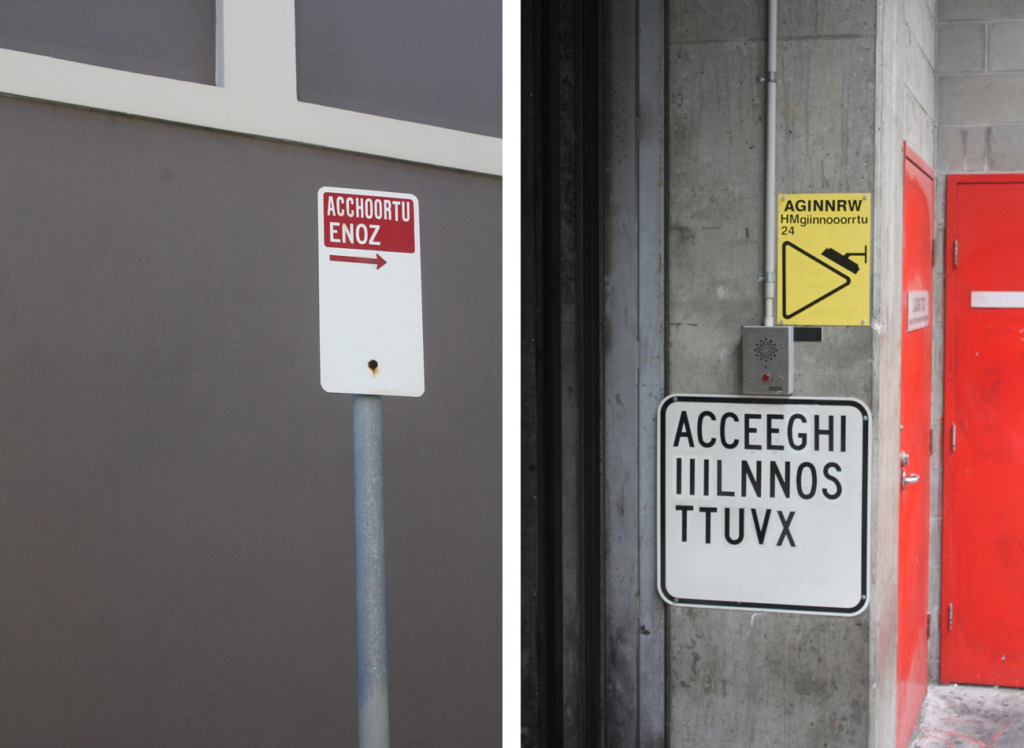
Holly O’Meehan, Reordering the Structured, 2016, digital print, Printer: Fitzgerald Photo Imaging , 90 x 194 x 0.01cm, 1/3
Byron Bay singer-songwriter and one of Australia’s most loved musicians, Pete Murray has released his new single, Take Me Down, alongside the announcement of his sixth studio album, Camacho — available 2 June. With over one million album sales to his name, the quiet achiever of Australian music will showcase new tracks and old favourites when he plays FAC as part of his epic national tour.
Beat-driven and anthemic, Take Me Down cleverly reveals a new direction for Pete, yet still manages to feel like a catch up with an old friend – his smooth, familiar voice both warm and inviting. “Take me down is about a beautiful relationship with an unknown future,” says Pete. “It’s about not knowing how much time is left and being in the moment. It’s emotive, moody, sexual and vulnerable.”
Determined to shake things up and find a fresh sound for the album, Pete explored different writing and recording techniques. “My main goal was to work with loops and beats and to have cool, phat drum sound,” says Pete. He collaborated with hip hop producer Trials (AB Original) to achieve the drum sounds he was looking for, and saddled up with an array of well-known industry talent to get the Camacho show on the road. “There was only one guy that I was interested in mixing this album and that was Eric J Dubowsky. He was starting to do a lot of phat, warm sounds and I really wanted this flavour of mixing on my album.” Also in the assemblage was Aussie producer Tony Buchen (Montaigne, The Preatures, Bob Evans), Sydney-based producer One Above aka Andrew Burford (Hilltop Hoods, Drapht, Allday), and ARIA winning producer Jon Hume (Matt Corby, Lisa Mitchell).
“The thing I wanted to do different with this album was to take my time and get it right. So many times in the past I have jumped into a studio for 4–6 weeks and recorded an album. Once the recording time is over, so is the album,” explains Pete, “with Camacho there was no rush, it was going to be finished when it was finished.”
And finished it is – guaranteed to be lapped up by new and old fans alike, Pete Murray has delivered a cool, uplifting, emotive, and powerful album and it will be celebrated and brought to life on the greatly anticipated Camacho Tour. Following sell-out shows across the country, the 32-date tour will take in capital cities and a host of regional centres throughout July, August and September.
Pumped to hit the road and play his new tunes for fans across Australia, Pete enthuses, “I’ll be taking the full band on the road and heading to a stack of places I haven’t been to in a while. I’m also really excited about playing the new music for the first time and cannot wait to get out there and see the crowd’s reaction.”
Camacho is set for release on 2 June and is available to pre-order from petemurray.com
Pete Murray plays Fremantle Arts Centre on Sat 2 Sep. Click here for details
Opening 6:30pm | Fri 31 Mar | Free | Exhibition Runs Sat 1 Apr – Sun 21 May
Step inside one of the most controversial and outwardly hedonistic religious movements to arrive in Australia in Fremantle Arts Centre’s provocative new exhibition Orange: Sannyas in Fremantle. Featuring newly commissioned multimedia works, including an absorbing virtual reality experience based around the group’s daily meditation practices – the exhibition investigates the legacy of the ‘Orange People’.
Dedicated to its leader Indian guru Bhagwan Shree Rajneesh (1931-1990) – later known as Osho – this highly tumultuous movement grew to global prominence in the 1980s. Fremantle became one of the major centres worldwide as many devotees moved in and many locals converted.
Recognisable for their orange-coloured clothes, disciples or Sannyasins – a term traditionally related to Indian religious discipleship – were typically well educated and wealthy.
The movement combined Western materialism with Eastern spiritualism, garnering intense public interest and controversy, particularly surrounding disciples’ sexual practices. The Orange People were a conspicuous and powerful element in the Fremantle community for a few years until they abruptly de-camped to the south – foretelling the upheaval, scandal and implosion of the international movement.
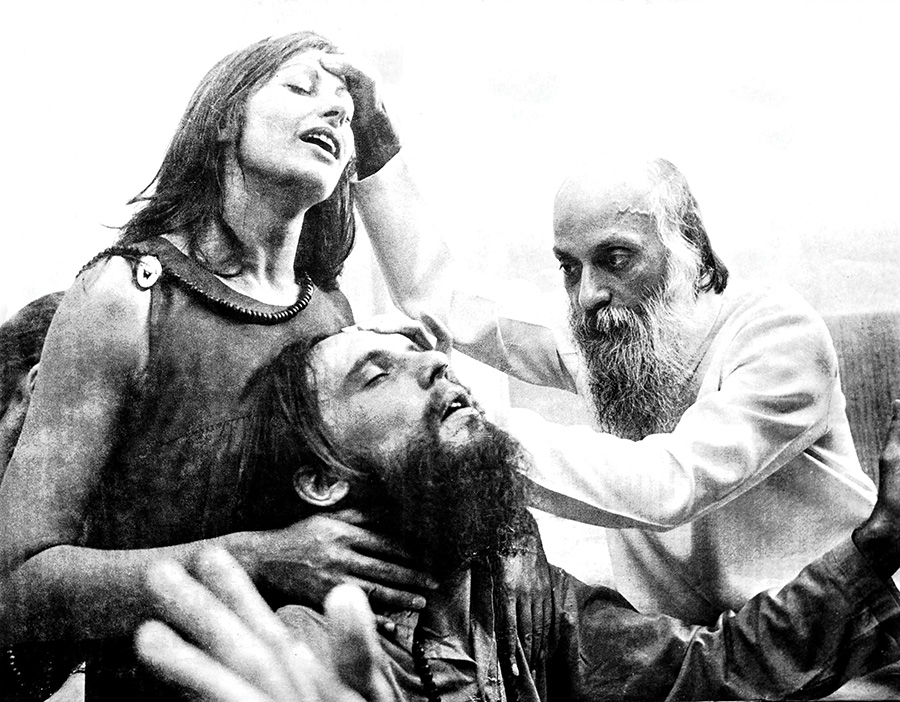
Osho & Sannyasins during Darshan, Poona, Rajneesh Foundation Newsletter, vol.23, 1 December 1979
Curated by FAC’s Dr Ric Spencer and Sannyasin kid Sohan Ariel Hayes, Orange reflects upon the public confusion and fascination surrounding the Orange People and presents an insight into a tumultuous time in Fremantle’s social history from those within the movement.
Alongside contemporary responses the exhibition showcases religious paraphernalia, archival material and interviews from Sannyasin kids, now in their 40s.
Curator Dr Ric Spencer said: “It’s wonderful to see such a colourful and vivacious period in Fremantle’s history brought to life in FAC’s galleries, with newly commissioned work from local artists and contributions from the Sannyas community this will be a lively foray into the world of Osho and 1980s Fremantle.”
Sohan Ariel Hayes grew up in Fremantle’s Sannyasin community from age five to eight, living with his Sannyas parents in the commune on Collie Street. For Orange, Hayes has drawn on his childhood memories of the movement to create Dynamic – a virtual reality work that explores the dynamic meditation practices undertaken daily by Sannyasins, including his parents.
This highly physical form of meditation often took place in a group where meditators wore blindfolds and a minimum of clothing as they screamed, hyperventilated and rolled around on the ground to reach a place of inner peace.
Dynamic will be housed within a padded orange room, complete with a foam floor and ceiling. Viewers will enter a virtual platform where the sun is slowly setting as lights shoot across the sky in time to a percussive soundtrack. Intercut with archival footage of Sannyas meditating, the VR work will encourage viewers to move.
The artist has also collected Sannyas memorabilia to create an intimate reading space which visitors will be invited to peruse in FAC’s Main Gallery.
“Much of Sannyas happened in ordinary domestic environments, in lounge rooms, in kitchens, in gardens, in bedrooms. The installation transforms the fireplaces in the Main Gallery into a shrine and sitting area populated with significant publications, objects and artworks relating to the movement,” Hayes said.
WA artist Loren Holmes will construct The explosive silence, stretching across FAC’s Hallway Gallery. This 2.4m long box features a mosaiced media wall filled with newspapers, magazines and archival material from the late 1970-1980s that explores the emergence and dissolution of the Sannyas movement.
Set behind this public archive is a collection of intimate moments between Sannyasins and occasionally Osho, which can only be viewed through a series of peepholes.
Holmes will also present Where is Utopia?. This visual reconstruction of Rajneeshpuram, the infamous Rajneesh city in Oregon, USA offers an aerial view of the place, with stories of the Orange city and its devotees interwoven through the work.
Established in 1981 by Osho and his followers, Rajneeshpuram grew into a fully functioning city complete with an airport, sewage system, retail outlets and restaurants. The guru was infamous for his consumerist hedonism, epitomised by his collection of 93 Rolls-Royces, earning him the title of “Rolls-Royce guru” in the USA.
In a tongue-and-cheek reference to the dual lives of the spiritual leader, WA artists Dave Brophy and Bevan Honey will broadcast their own Rolls-Royce spirit radio. Featuring a colour-separated print of a model Rolls-Royce, viewers will hear recordings of Osho emanating from ‘inside’ the car’s radio.
Orange will explore the experiences of Fremantle’s Sannyas community through a series of collaborative and interview-based works. Former FAC Print Award winner Poppy van Oorde-Grainger (WA) has collaborated with now-grown Sannyasin kids to create Letting Go. The work reflects on their experiences through dance and music.

Poppy van Oorde-Grainger, Letting Go, 2017, HD video 3:30mins, video still
Artist and practicing Sannyasin Naren Farquharson (WA) will present a salon hang of Sannyas paraphernalia, including paintings, drawings, photographs and artefacts dating from the height of the Fremantle movement.
In a new video work, Joseph London will project Sannyasin voices over iconic Fremantle landscapes filmed from dawn to dusk – a significant time and colour scheme for the Sannyasins. These revealing excerpts from those inside the movement offer insight into Sannyas’ ideals of enlightenment, surrender and the master-disciple relationship.
Osho’s principle of surrender as a state of no-mind, no ego and letting go is a key theme throughout the exhibition. Disciples were encouraged to embrace the moment, reaching a point of enlightenment where they released conscious control to respond in a purely intuitive manner.
In reference to this ‘art of surrender’, Joshua Webb has constructed a stunning light sculpture based on Osho’s sacred geometric shapes. Suspended from the ceiling, the glowing orange work offers an absorbing, symbolic take on the movement.
By privileging the perspective of artists raised as Sannyasins, Orange offers rare insight into the inner workings of the enigmatic spiritual group. More than thirty years later, the deeply personal responses speak to the enduring, mixed legacy of the Orange People for both the individuals involved and the port city.
For media enquiries contact Communications Assistant Sam Leung at saml@fremantle.wa.gov.au or 08 9432 9565.
Artist Biographies
Dave Brophy (WA) is an Australian artist whose practice stems from investigations into the phenomenology of surfing. His work meditates on the experiential, psychological and spiritual exploration of his experiences as a surfer and how these may be translated via the vernacular of visual art. He was highly commended in the 2014 Hatched National Graduate Exhibition, Perth Institute of Contemporary Art; selected to exhibit in HERE&NOW15, Lawrence Wilson Art Gallery; a finalist in the 2016 Blake Prize; and has recently been selected for the 2016 Wyndham Art Prize.
Naren Farquharson (WA) was born in Scotland, studying at Glasgow School of Art and later travelling extensively throughout the world. During his time in India he visited Osho’s original ashram in Pune and afterwards travelled to Fremantle in 1979 where he took Sannyas. In 1982 and 1983 Farquharson travelled to Rajneeshpuram, Oregon for the annual International Sannyas Celebration. On returning to Fremantle he studied at Claremont School of Art and undertook a Bachelor of Fine Art at Curtin University.
J. David Franzke (VIC) is a Melbourne-based composer and sound designer. His work spans film, theatre and installation as well as the production of numerous albums, both as solo works and in collaboration with other composers and sound artists. He has worked with many of Australia’s pre-eminent theatre directors, visual artists and composers, and has collaborated with Cologne-based composer Bernd Friedmann since 1996 on various projects.
Sohan Ariel Hayes (WA) is an award-winning animator, art director and visual artist with an inter-disciplinary arts practice. His socially-engaged and provocative work has included animation, films, theatre, interactive installation, large-scale site-based projections, games and public art. Hayes directs and collaborates across film and video art work and expanded cinema projects, with a recent interest in developing and deploying new technologies and custom-made physical interfaces.
Loren Holmes (WA) is a multi-disciplinary artist and designer working across architecture, video, graphic design and illustration. Her practice focuses on the distorted layering of processes and information to provoke questions about perception. Alongside her professional work, which has spanned across Perth, Melbourne and London, Holmes teaches within the Architecture and Integrated Design streams at UWA’s School of Architecture, Landscape and Visual Arts. She holds degrees in Environmental Design from UWA and Architecture from RMIT.
Bevan Honey (WA) is a Fremantle-based artist with an extensive exhibition history, including solo exhibitions at the Perth Institute of Contemporary Art, Galerie Dusseldorf, Lawrence Wilson Art Gallery, Monash Faculty Gallery and Tin Sheds Gallery. He interrogates cycles of boom and bust, failed building projects and consumerist fetishes through his macho machines, wall installations, architectural models, photography and drawings. He has participated in group shows throughout Australia and his work is held in a number of collections, including the Art Gallery of Western Australia, Art Gallery of South Australia, National Gallery of Australia, The Horne Collection and Artbank. In 2009 Honey was the recipient of the Mark Howlett Foundation Fellowship.
Joseph London (WA) is currently completing a PhD in film, for which he is making a long-form documentary on the Sannyasin community in Fremantle. As a child growing up in Fremantle at the height of the Sannyas movement, London was both a naïve observer and curious outsider to the community and its inner workings. His PhD explores the historical documentaries about subjects that are in some way ‘unfilmable’, with landscape acting as a space for absorbing and contemplating that which is beyond representation.
Poppy van Oorde-Grainger (WA) is an artist and filmmaker who specialises in collaborating with communities. She has made work for Nickelodeon; Perth International Arts Festival; London International Festival of Theatre; Museum of Contemporary Art, Sydney; Museum of Contemporary Art Chengdu, China; and Macrobert, Scotland. Her previous accolades include winning the Fremantle Arts Centre Print Award supported by Little Creatures Brewing and the Australia Council Kirk Robson Award.
Joshua Webb (WA) has exhibited across Australia, the USA and Europe. His artistic practice has been in parallel to his academic pursuits. He holds a Bachelor of Fine Arts, Curtin University and Master of Fine Arts – Sculpture, Rhode Island School of Design, USA.
The latest edition of the FAC What’s On is now available to read online. Find everything that’s happening at FAC from April to June 2017, including Orange: Sannyas in Fremantle, the full program of Revealed events, a very special Sonic Sessions featuring Billy Bragg and much more!
http://issuu.com/fremantleartscentre/docs/wo_2017_q2_online?e=2557115/46395239
Returning to Fremantle Arts Centre in 2017, Revealed is an annual program that provides valuable public exposure for new and emerging Aboriginal artists from all over the state. Revealed comprises an art market, exhibition and artist talks and features artists from 25 WA Aboriginal art centres.
The exhibition showcases the diverse vitality of Aboriginal art across the state, featuring works from the best new and emerging artists, all of which are for sale. The art market is also an opportunity to purchase original works from new and established artists, with all profits returning to the art centres and makers.
In 2017, the program includes a powerful collection of artist-led talks in Our Story, Your Story: WA Aboriginal Artists in Conversation, open to artists, those working in the sector and for anyone with an interest in contemporary Aboriginal art. In addition to the public events, Revealed also offers a comprehensive professional development program for Aboriginal artists and art centre staff.
FAC Director Jim Cathcart: “Revealed’s a chance to meet artists from some of the most remote locations in WA. The program celebrates the incredible works that contemporary artists are making throughout our diverse state and offers Aboriginal artists a public platform to market and sell their work, along with invaluable opportunities for artistic and professional development.”
Revealed is an initiative of the WA State Government through the Department of Culture and the Arts; and the Australian Government through the Indigenous Visual Arts Industry Support program.

Patrick Green, Tjukurla community. Image courtesy of Tjarlirli Arts
Our Story, Your Story: WA Aboriginal Artists in Conversation
Fri 7 Apr | 10am–12pm | Inner Courtyard | Free
The Revealed artist talks are an opportunity to participate in a powerful Aboriginal artist-led conversation about the importance and diversity of art and culture from across WA. Audiences will listen and interact with senior and emerging artists from unique communities and regions.
The talks will reveal new and unexpected insights into to the ever-changing nature of Aboriginal cultural and artistic expression. Dot painting myths will be broken as artists discuss the new techniques and technologies being harnessed to produce textiles, fashion, experimental video, animation, performance and language preservation.
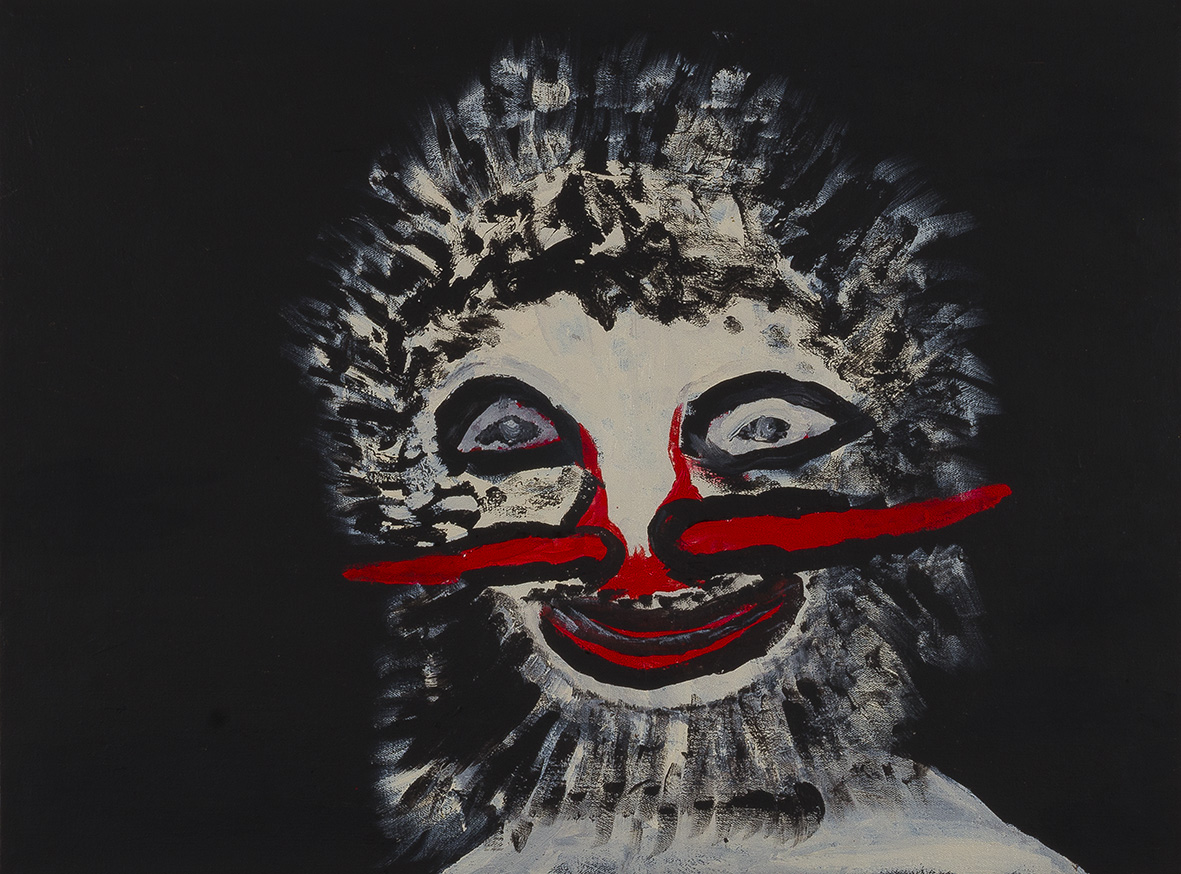
Victor Burton, Nyiirnkajarra, 2016, 46 x 61cm, acrylic on canvas, image courtesy of the arist and Spinifex Hill Studios, Port Hedland
Revealed Exhibition: New & Emerging WA Aboriginal Artists
Opening Fri 7 Apr | 6:30pm | Free | Exhibition runs Sat 8 Apr – Sun 21 May
The Revealed Exhibition features works by more than 75 of the best new and emerging Aboriginal artists from all over WA, showcasing the diverse and vibrant state of contemporary Aboriginal art. Featuring paintings, prints, wood carvings, photography, textiles, video, weaving and more, this enticing and sometimes surprising exhibition presents the work of artists from extremely remote areas alongside those from regional towns and metropolitan Perth.
All works in the exhibition are for sale.

Revealed Market 2016. Photography by Jessica Wyld
Revealed WA Aboriginal Art Market
Sat 8 Apr | 10am–5pm | Front Garden | Free Entry
Don’t miss this once-a-year opportunity to buy works directly from emerging and established Aboriginal artists. With works starting at $50 and 100% of profits from sales returning to the makers and art centres, this is a great chance for the public to ethically purchase affordable, original works.
Travelling from all over the state the Revealed Market brings together artists from the Kimberley, Pilbara, Mid-West, Goldfields, Western Desert, Great Southern and metropolitan areas, showcasing the vibrant diversity of Aboriginal art across the state.
Works for sale will include paintings, textiles, woven items, artefacts, ceramics, jewellery and more.

We caught up with Piñata Percussion Artistic Director Dr Louise Devenish to chat about their upcoming performance Interior Echo. The show is part of offBEAT, FAC’s annual celebration of rhythm.
You’re one of WA’s most in-demand percussionists, performing in electro-acoustic sextet Decibel, Speak Percussion and The Sound Collectors, and are Head of Percussion at UWA’s School of Music. Tell us a bit about your musical background and how you first discovered percussion. I started percussion lessons in Year 8, but had music in my life from childhood. I always loved music but it wasn’t until I started university that I really discovered what percussion could be and became completely hooked on percussion instruments and music. Over the years my explorations of percussion have included orchestral playing, world music and experimental music. At the moment I am really interested in what has recently been described as post-instrumental practice – which is what a lot of percussionists are doing. We are using our orchestral instrumental training to explore new ideas including building instruments, working with electronics and blending aspects of the visual and theatre arts with percussion music. I’m also very interested in Australian music – there are some amazing creative minds at work at the moment making vital contributions to the national and international music scenes and you will hear some of them in this concert!
You formed Piñata Percussion at UWA in 2013. What inspired this new ensemble? I’ve always loved ensemble music, and much of my performance work has been with various percussion ensembles. As the number of percussion students at UWA has grown it became possible to form a new ensemble, and for me to share some of my experiences and musical discoveries with new players in Perth. Doing so has allowed the students to explore Australian music and large-scale percussive masterworks of the twentieth century through a season of projects each year, and working with this wonderful group of players is such a joy for me.
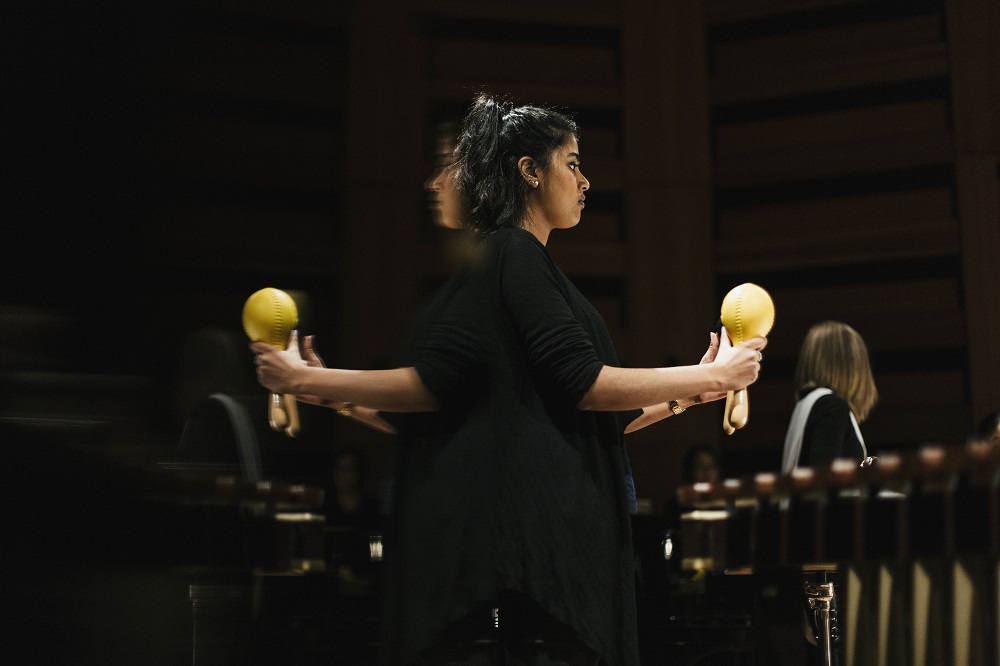
What’s a Piñata Percussion performance like? Piñata performances are unexpected musical adventures – each concert includes music that hasn’t been heard in Perth before. This often means that unusual instruments are on display, and the instrumental steups are fascinating to look at as well as listen to. The nine players work exceptionally well together, and communicate great energy to each other and to audiences in their performances, which is quite special to experience live.
For Interior Echo listeners will travel through FAC’s historic spaces in a promenade performance. What kind of musical experience will they find in each room? Each room will contain different combinations of performers on different instruments and the music performed has been programmed to complement the vibe of each room. For example, in the main gallery, which is currently quite dark and mysterious with a beautiful black and white print, the audience will hear soft, spacious music, but in the painting studio they will hear an interlocking groove-based work using found objects as instruments. The event will be a series of exciting sonic discoveries, made more exciting by the opportunity to explore otherwise off-limits rooms in the FAC building.
What are some of the more unusual instruments we’ll see on the night? Car springs, noodle bowls, microtonally tuned bits of metal, glass jars, coffee cups and saucepans all make an appearance, alongside the usual percussion suspects such as drum kit, sampler keyboard, vibraphones and marimbas. It will really be quite an adventure!
Piñata Percussion perform Interior Echo on Friday 24 March. Click here for more details and to buy tickets.
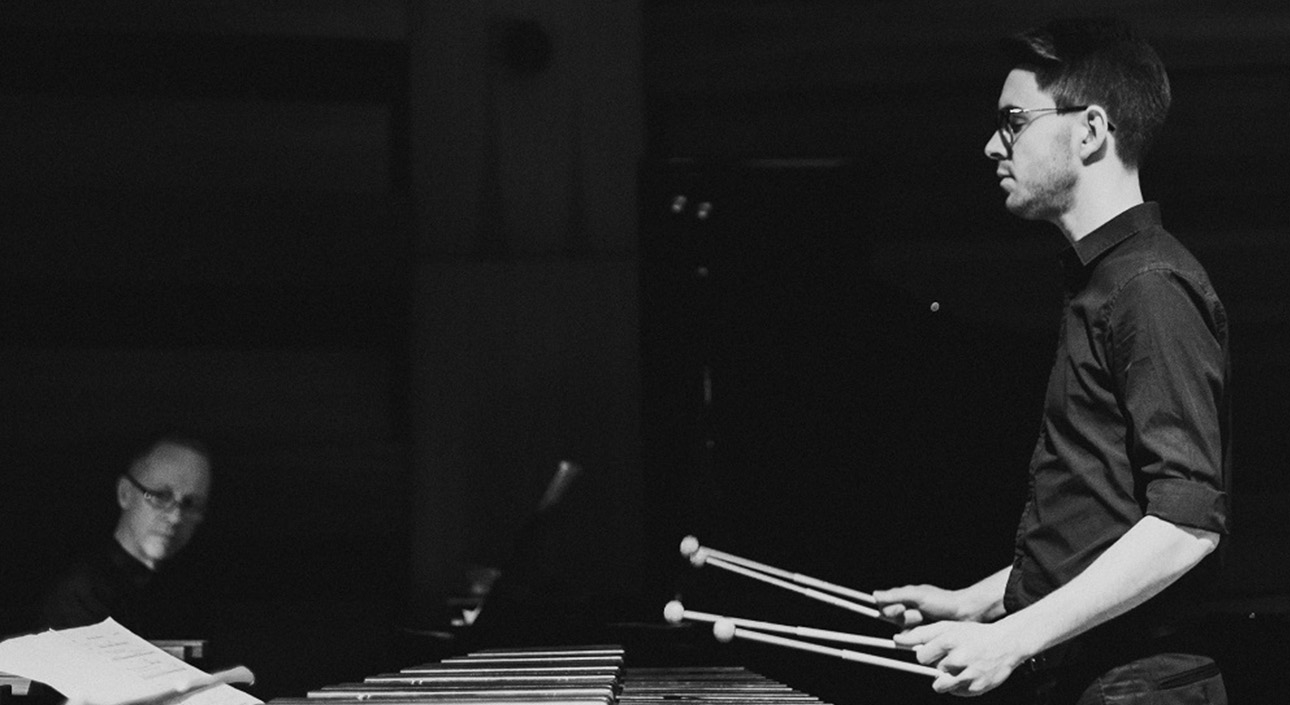
We’re excited to welcome WA artist and project manager Emma Buswell to the FAC team as our new Print Award Coordinator. Emma filled us in on some of her arts highlights and what she’s looking forward to for this year’s award and exhibition.
Along with being an arts administrator, you’re an artist yourself and have worked with numerous arts organisations. Tell us about your background in the industry and when it first began.
I’ve always been obsessed with galleries and art, so for me there was really no other option than to study it. I studied at Curtin University and from there I developed an interest in collaborative practice and curatorial processes. Leaving uni and the excellent safety net that it provided, I wanted to work more with individuals and alternative vacant spaces in the city. I think it’s really important to make your own opportunities and in Perth we have an incredible amount of autonomy to be able to do this. In my case, that meant pursuing an ongoing interest in architecture and how unused or empty spaces in cities have the potential to provide platforms for creative practice. I started a little gallery in a two person office space that boasted panoramic views of the city (well, at least the bathroom did) the year after graduating.
I’ve also worked at PICA for several years and most recently as a curator at Success, where I had the opportunity to work with nationally and internationally acclaimed artists. All of this computer work and arts admin is balanced of course by making things and working as a practicing artist.
Also a big welcome to FAC! How does it feel to be part of the team?
So INCREDIBLE!! There are so many talented people in the one place, I mean surely FAC’s the only place that has a Front of House with a PhD. Everyone’s been so fantastic and I can’t wait to work with all the staff more over the next year. FAC has so many artists on staff as well, so we all understand many of the processes that go into actually making work for an exhibition, and the emotional upheaval that goes along with that. It makes for a truly creative and diverse workplace.

Emma Buswell, Mickelmerch: Paying Dues to Wronged Heroes One $ at a Time, 2016, various materials. Photography by Zan Wimberley. Image courtesy of Firstdraft
The Fremantle Arts Centre Print Award supported by Little Creatures Brewing has been running for more than 40 years now. How do you feel about coordinating this year’s award?
Pretty excited, it’s a fantastic opportunity and I can’t wait to see what applications we get this year. If the last few years are any indication, it’ll be a whoppa. Simone, who’s managed the award for the past few years, has left such massive shoes to fill and hopefully my disproportionately big feet (literally, they are too big for my height) and I are up to the task.
Every year the Print Award demonstrates the lengths to which artists will go to test boundaries and manipulate the fabric of printmaking, and I can only imagine the kinds of inventive and rigorous work that this year’s award will bring.
As an arts insider, what’re your tips for Perth galleries and places to visit?
Arts insider! Like a spy? I think Freo is the place to be this year. As well as FAC there’s a host of incredible new artist-run spaces opening up, so it’s going to be pretty exciting. Carla Adams is opening a new gallery called SMART CASUAL. Polizia, opened by a few of the Success alumni, is also set to launch in a few weeks. I think it’s really important to see what’s being produced at this level as these are the artists and arts workers who’ll probably end up as the major contributors in Perth and Western Australian art in the coming decades.
Finally the big question: dogs or cats?
Doggos of course, did you really need to ask?
Want to learn more about the FAC Print Award or apply for the 2017 award and exhibition? Visit our For Artists section.
